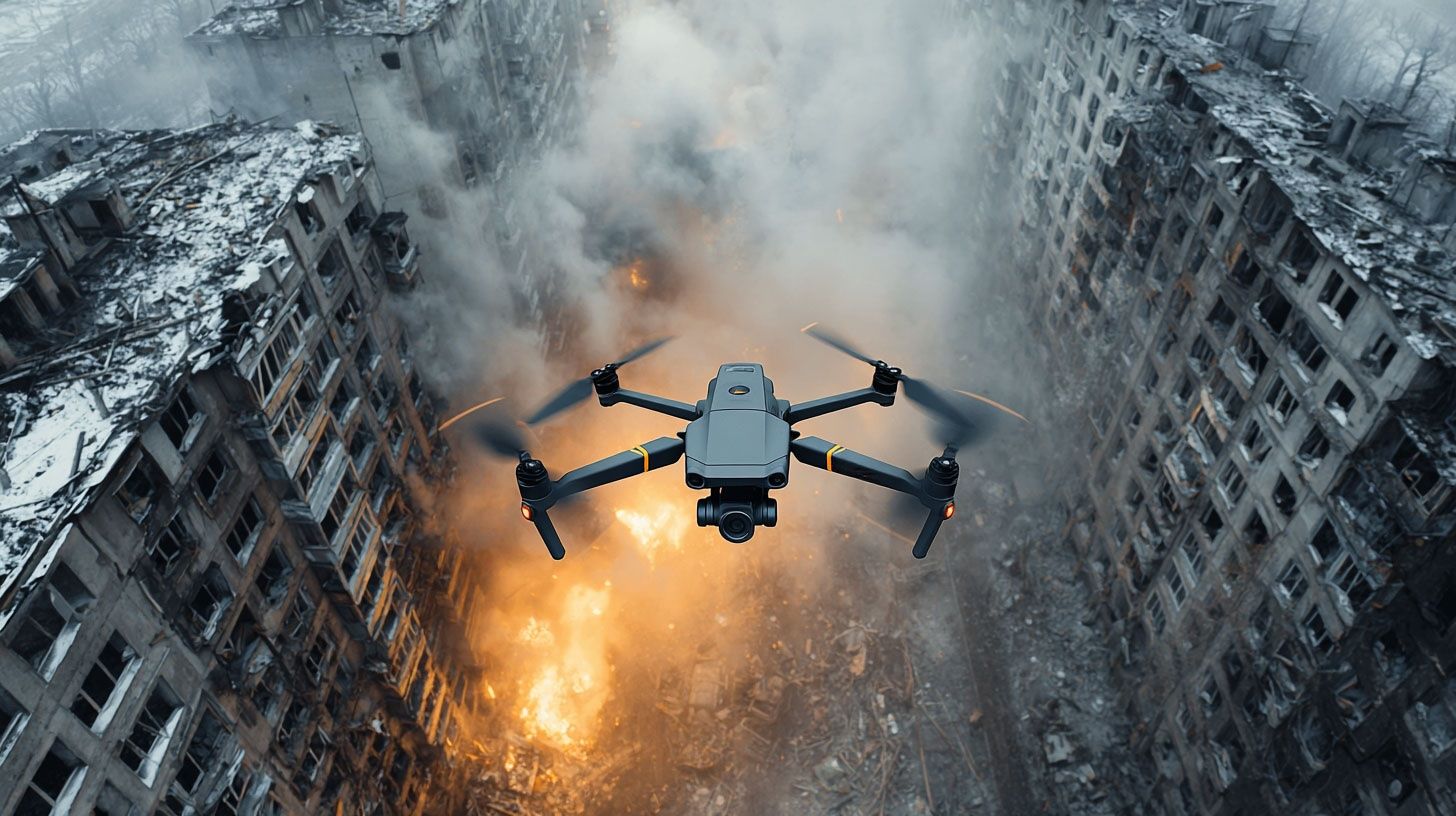- In February 2023 Ukraine abolished value-added tax (VAT) and import duties on drones and related equipment, with exemptions extended to at least January 1, 2025 under martial law.
- Under the “235 Preference,” international postal and express UAV shipments to Ukraine are fully exempt from customs duties and VAT.
- In early 2023 the Cabinet canceled the requirement for volunteer importers to provide an end-user guarantee letter and waived dual-use drone licenses.
- Since April 2024 Ukraine uses an online humanitarian cargo system on good.gov.ua that assigns a unique code to drone shipments for fast border clearance.
- DJI direct sales to Ukraine stopped in 2022 due to external export controls, forcing buyers to use third-country routes.
- Private individuals can import drones under martial law without VAT or duty, with no special permit required for consumer drones under 20 kg.
- Ukraine has rapidly expanded its domestic drone industry, with officials claiming production up to 150,000 drones per month in 2023–2024 and a target of 2 million per year.
- Major Ukrainian manufacturers include UkrSpecSystems with the PD-2 and Shark, Athlon Avia with the Furia and Hrim, Skyeton with the Raybird-3, UkrJet with the UJ-22 Beaver, and Antonov with the AN-196 Lyuty.
- The Army of Drones initiative has delivered hundreds of reconnaissance quadcopters and dozens of military UAVs to front-line units.
- In 2024 Ukraine’s Ministry of Defense bulk-purchased about 4,000 DJI Mavic 3 drones, averaging $3,200 for the Mavic 3E and $4,900 for the Mavic 3T.
Taxes and Customs Duties on Drone Imports
Current Tax Exemptions: As of 2023, Ukraine has waived value-added tax (VAT) and customs duties on the import of drones and related equipment due to the wartime need [1]. In February 2023, the parliament adopted bills abolishing VAT (normally 20%) and import tariffs on drones, thermal imagers, night vision devices, and radios, removing “all bureaucratic restrictions” on importing these defense-critical goods [2]. This policy, developed with volunteer organizations, was aimed at speeding deliveries to the front. Further laws in July 2023 amended the Customs and Tax Codes to solidify these exemptions until at least January 1, 2025 (or the end of martial law) [3]. Under this “235 Preference”, international postal and express shipments containing unmanned aerial vehicles (UAVs) to Ukraine are fully exempt from customs duties and VAT [4]. In practice, this means importers do not pay the usual taxes on drones during the war.
Previous Rules: Prior to these wartime measures, imported drones would have incurred standard import costs – typically 20% VAT and any applicable customs duty (often around 0–10% depending on the drone’s classification). Importers also faced paperwork for dual-use goods. These costs and red tape have now been eliminated for drones and many components “important for our defense” [5]. For example, a volunteer foundation or company bringing in a DJI quadcopter in 2021 would have paid VAT and possibly a tariff; in 2023–2024, they pay 0% under the exemption [6] [7]. The removal of taxes significantly lowers the cost of supplying drones to Ukrainian users.
Extension and Scope: These tax breaks have been repeatedly extended given the ongoing conflict [8]. They cover complete drones as well as drone parts and accessories (like batteries, cameras) when imported for security and defense needs [9]. Notably, laws passed in late 2022 and early 2023 also scrapped import duties on components (e.g. fiber-optic cables for UAVs) to boost domestic drone production [10]. In effect, any UAV – from small commercial quadcopters to larger reconnaissance drones – can currently be imported into Ukraine without paying import taxes, as long as they are destined for defense or humanitarian use under the martial law provisions [11] [12].
Sources: Parliamentary bills and government decrees (2023) [13] [14]; Ukraine’s Customs Code amendments [15].
Shipping and Logistics for Drone Imports
Importing drones into Ukraine involves various shipping options, and the logistics depend on who is buying and the urgency. International couriers and postal services are key for delivering small drones. Companies like DHL, FedEx, and UPS typically offer express delivery to Ukraine, although some suspended service early in the war. Many importers now rely on specialized freight forwarders and regional couriers that have continued operations. For instance, Ukrainian logistics firms (like GlobalPost) arrange daily imports from the EU with fast delivery times [16]. These services consolidate shipments in neighboring countries (e.g. Poland) and transport them by road or air into Ukraine, navigating customs on behalf of the sender.
Costs: Shipping costs vary by size, weight, and speed. Small consumer drones (e.g. a 1–2 kg quadcopter in its case) sent by air courier from Europe or the U.S. might cost on the order of $50–$150 in shipping fees, whereas bulk shipments of multiple drones can be more cost-effective per unit. Economy ground transport from EU countries (like Poland or Germany) is generally cheaper but slower (several days), while express air shipments (from the U.S. or Asia) arrive faster (2–5 days) at higher cost. During the war, many carriers offer discounted or volunteer shipping for humanitarian supplies, including drones destined for the front. For example, GlobalPost advertises cost optimization for clients and multiple carrier options (FedEx, DHL, UPS, etc.) to find affordable routes [17] [18]. Volunteer networks also hand-carry or drive in donated drones, effectively at no cost to the end user.
Logistics by Region of Origin: Drones sourced from China (e.g. DJI, Autel) often ship indirectly. Since DJI halted direct sales to Ukraine in 2022, Ukrainian buyers obtain Chinese-made drones via third countries [19]. Commonly, suppliers in the EU (Poland, Baltic states) or the USA purchase the units and then send them to Ukraine. This adds some transit time and cost, but it has become a routine pipeline. European-origin drones or stock (like French Parrot models) can be shipped within Europe to Ukraine easily by road, often reaching Ukraine in a few days. US-origin drones or components typically fly to Europe or directly to Ukraine by air freight. Despite the war, Kyiv’s Boryspil Airport handles cargo flights, and land routes from Poland remain open and heavily used for deliveries.
Handling and Customs Clearance: Because drones are now duty-free, customs clearance is relatively fast – especially for shipments labeled under the special UAV code (UKTZED 8806221010) which flags them for the tax-free “defense” treatment [20]. Shipping companies help fill out the simplified customs declaration for these items. Under martial law, the process has been streamlined: no import taxes to calculate, and fewer bureaucratic delays. As GlobalPost notes, “drones without customs clearance” are now possible – meaning the UAVs move through customs with minimal formalities [21]. This is a stark change from pre-war times when importers might need to provide technical certificates or pay bond fees.
In summary, whether it’s an individual ordering a drone online, a company importing a batch for resale, or a charity shipping dozens for the army, multiple logistics channels exist to get drones into Ukraine quickly. Costs can range from nominal (for donated shipments via volunteers) up to a few hundred dollars for express international delivery, but overall the process has become more accessible. The Ukrainian government’s facilitation (tax breaks and simplified procedures) combined with dedicated logistics networks has created a relatively efficient supply line for drones despite the conflict.
Sources: GlobalPost logistics guidance [22]; volunteer shipment reports.
Legal Procedures and Import Restrictions
Simplified Import Procedures: The Ukrainian government has greatly simplified legal requirements for importing drones since 2022. Previously, drones (especially those with military or dual-use capability) required various permits – such as end-user certificates or letters of guarantee from a military unit when volunteers imported them. In early 2023 these requirements were dropped. The Cabinet of Ministers canceled the requirement for volunteer importers to provide a guarantee letter from a military end-user [23], after public criticism that such red tape was delaying critical equipment. Now volunteers and organizations can bring in drones without needing advance approval from defense authorities. Furthermore, importers no longer need to obtain special licenses for dual-use drone technology. The government removed requirements for certain certificates and paperwork for civilian and dual-use drones, recognizing they are vital for the war effort [24] [25].
Volunteer and Charity Imports: For recognized volunteer organizations and charities, importing drones is treated as bringing in humanitarian aid or defense aid. Since April 2024, Ukraine has implemented an electronic system to register humanitarian cargo including drones [26] [27]. A charity must register on the government portal (good.gov.ua), list the items (e.g. type and quantity of drones), and obtain a unique code for the shipment [28]. This electronic declaration replaces the old paper form. The process is designed to be quick (registration can be done online with an electronic signature), and the code is presented at the border for smooth customs clearance [29]. Importantly, as of 2024, volunteer groups no longer need a formal letter from a military unit requesting the drones – a letter which was previously required by customs as proof of need [30]. The abolition of this “letter of request” means NGOs can import drones proactively and then distribute them to units in need. Volunteers must later report how the drones were distributed (to prevent misuse or resale) [31] [32], but this reporting is also streamlined via the electronic system.
For Companies and Individuals: Private companies importing drones (for commercial sale or their own use) face minimal restrictions currently. They still must comply with standard product regulations (e.g. radio frequency standards), but many certification rules were relaxed. The government in 2023 removed requirements for additional technical documents that used to accompany drone imports [33]. For example, importers no longer need to present a State Service of Export Control conclusion for ordinary DJI-type drones. Companies simply file a customs declaration (now often simplified if using express freight) and benefit from the tax exemptions. Private individuals can receive drones by mail or bring them in person without paying duty, as long as the drones are not exceptionally large or military-grade. Consumer drones under 20 kg are not subject to any special import license in Ukraine. Personal imports by mail follow the general martial-law rule that drones are duty/VAT free [34]. If an individual physically carries a drone across the border (e.g. bringing a drone from a trip abroad), it is generally allowed and would be treated as personal belongings or humanitarian donation if declared as such. There is no legal ban on personal drone imports, though individuals must abide by any export controls from the originating country (for instance, the U.S. or EU might restrict export of high-end military drones, but not standard consumer models).
Restrictions: During wartime, Ukraine’s focus is on facilitating imports, so there are few Ukraine-imposed restrictions on drones. One notable limitation comes from external export controls: China’s DJI has stopped direct sales of its drones to Ukraine (and to Western countries that might forward them) [35] [36]. This means Ukrainian buyers cannot simply order from the DJI store in China; they must go through third-party sellers. This is a commercial restriction rather than a Ukrainian law, but it affects availability. Similarly, some high-end components made in the U.S. or EU (like thermal cameras, or military-grade parts) might require export licenses to send to Ukraine, due to those countries’ regulations [37]. For example, Aerorozvidka noted that many U.S.-made parts are prohibited from export to Ukraine under export controls [38]. Such restrictions apply mostly to advanced technology (encryption modules, thermal sensors, etc.), not to off-the-shelf drones. On the Ukrainian side, once the drones arrive, there are no import quotas or bans – even large strike UAVs have been imported or donated freely through government channels.
In summary, Ukraine has minimized legal hurdles for drone imports for all categories of buyers. Volunteers and NGOs enjoy a fast-track humanitarian import system without the old paperwork [39] [40]. Companies and individuals benefit from tax-free and simplified customs with no special licensing needed for standard drones. The main “restrictions” are thus external (manufacturer or exporter limits), not Ukrainian import law. This permissive regime aligns with international best practices focusing on export control rather than import control [41] – Ukraine is essentially welcoming drones and only monitoring distribution to prevent abuse.
Sources: Government and NBU announcements [42] [43]; Better Regulation Delivery Office analysis [44] [45]; Ukrinform reports on new volunteer import rules [46].
Differences in Import Process by Buyer Category
The import process and regulations for drones can vary slightly depending on who the buyer or importer is. Below is a breakdown by category, highlighting key differences:
| Buyer Category | Taxes & Duties | Import Procedure | Restrictions/Requirements |
|---|---|---|---|
| Private Individuals | No import VAT or duty on drones under martial law [47]. (Previously 20% VAT + tariff.) | Can order via postal or courier services; simplified customs as personal goods. If carrying across border, declare at customs (usually no fee due to exemption). | No special permit needed for <20 kg consumer drones. Must comply with general civil aviation rules after import (registration if required for heavy drones). Exporter country rules apply (e.g. no DJI direct sales, must buy via third party) [48]. |
| Private Companies | No VAT/duty on import [49]. If reselling domestically, VAT will be applied at sale. | Standard commercial import via freight forwarder or courier. Fill out customs declaration (can use code for UAV to get exemption [50]). Bulk shipments possible through cargo channels (often via Poland). | Earlier certification requirements waived (no need for dual-use license for typical drones) [51]. Still must ensure drones meet telecom standards (frequency, etc.). If importing large/military UAVs, might coordinate with defense ministry. |
| NGOs & Volunteer Orgs | No VAT/duty – drones often imported as humanitarian aid, fully tax-exempt [52]. | Use humanitarian import system: register shipment online (good.gov.ua) [53], get code, fast-track at border. Or import via simplified customs if small parcels. Often work with volunteer carriers or supportive logistics firms. | No letter of guarantee needed (requirement removed) [54]. Must report distribution of drones after import (to prevent misuse) [55]. Generally unrestricted on types, but likely focus on small/medium drones. |
| Government & Official Procurement | No taxes (government imports of defense goods are tax-exempt by law) [56]. | Large orders via Ministry of Defense or other agencies. Often done through the Prozorro e-procurement system with international tenders [57]. Drones may be delivered directly by suppliers to military bases or MoD warehouses, bypassing regular customs (handled as military cargo). | Official import requires end-use to be government/military. Usually involves contracts and quality checks, but no import licensing needed beyond normal defense procurement approvals. Some high-end drones might be classified, handled in secret. |
| Ukrainian Armed Forces | N/A (Armed Forces receive drones duty-free, either via donations, volunteers, or MoD purchases) [58]. | Military units typically receive drones from government procurement or donations in-country. Direct import by a military unit is rare; they usually rely on MoD’s logistics or volunteer deliveries. If a unit does import, they can be listed as humanitarian aid recipient (since 2024, units can register to receive aid) [59]. | The Armed Forces can use any drones supplied – no legal limit on usage. If importing directly (e.g. special delivery from abroad), it’s treated as military supply with minimal customs formalities. Main restriction: they often avoid using certain Chinese drones in official capacity for security reasons [60] (DJI banned from MoD purchases initially, though this has evolved). |
Key Differences: Private individuals and companies follow a straightforward customs process with no fees, just like regular imports minus the taxes. NGOs have a dedicated humanitarian corridor with extra accountability but also special ease of importation [61]. Government and military imports are handled internally and are largely free from the standard import process – essentially a separate pipeline for defense material. All categories benefit from the tax exemptions and deregulation implemented since 2022, which level the playing field in terms of costs. The main distinctions lie in documentation and scale: volunteers use the humanitarian aid platform; companies use commercial invoices; the government uses formal contracts and may procure in large batches.
Sources: BRDO summary of regulatory changes [62] [63]; Ukrinform on humanitarian system [64] [65]; Prozorro procurement details [66].
Current Drone Market Prices and Origins
Ukraine’s demand for drones has surged, and popular models (often made in China) are sourced through various regions. Below is an overview of market prices for commonly imported drone models and how prices compare by region of origin:
- DJI Mavic 3 (Standard) – Prosumer quadcopter (China): In the U.S. and Europe, the Mavic 3 retails around $1,800–$2,000 for the base package. For example, DJI’s official store lists it at about $1,839 in the US [67]. European prices are slightly higher (~€1,800, roughly $1,950) due to VAT. In China, the price would ordinarily be slightly lower (DJI often prices ~10% less in its home market), but direct sales to Ukraine are halted [68]. Ukrainian importers buying from EU suppliers incur that ~$1.9k cost. Volunteer foundations have sometimes obtained wholesale discounts – purchasing Mavic 3s in bulk at lower prices than retail [69]. (In fact, Ukrainian charities consistently bought drones cheaper than EU store prices, likely through bulk orders [70].)
- DJI Mavic 3 Thermal (Mavic 3T) – Enterprise quadcopter with thermal camera (China): This model is in high demand for frontline night operations. It is significantly more expensive due to the thermal sensor. In Western markets, a Mavic 3T with accessory kit costs around $5,000. For instance, a Ukrainian Ministry of Defense contract in 2024 priced Mavic 3T packages (with 3 extra batteries and charger) at UAH 194,200 each (≈$4,888) [71]. This roughly aligns with the retail price in Europe (around €4,500–€5,000). The Mavic 3T units are manufactured in China, but since Chinese channels are closed to Ukraine, sourcing is through third countries. Despite the markup, these Chinese-made drones are still far cheaper than Western equivalents – a similar US-made thermal drone can cost well over $10k.
- DJI Mavic 3 Enterprise (3E) – Enterprise mapping drone (China): The 3E (without thermal) is a bit less costly. The Ukrainian MoD in the same 2024 tender bought Mavic 3E packages at UAH 126,900 each (≈$3,194) [72]. That suggests roughly $3.2k per unit including extras. Retail in the West is about $3,300 for a Fly More Combo. This illustrates that official procurements in Ukraine have been able to secure prices close to global retail, or slightly better.
- Autel EVO II Pro – *High-end camera drone (Autel Robotics, China/USA): Autel is a Chinese-founded company with U.S. subsidiaries, seen as an alternative to DJI. The EVO II Pro (6K camera) sells for around $2,000 in the U.S. [73]. European prices are similar (~€2,100). Autel hasn’t publicly embargoed Ukraine, so volunteer importers sometimes source Autel drones from the U.S. at retail. The Autel EVO II Dual (with thermal camera) is pricier, in the $4,000–$6,000 range [74]. These are comparable to DJI’s enterprise pricing. Autel drones coming via the U.S. or EU to Ukraine have the advantage of no extra import tax, just the shipping cost. Some volunteer groups chose Autel models when DJI supply was tight in 2022.
- Parrot ANAFI USA – Rugged reconnaissance mini-drone (Parrot, France): This is a NATO-aligned alternative that offers secure data links. Its price is much higher than Chinese drones – roughly $7,000+ per unit for the USA model with advanced sensors. Parrot drones are made in Europe (France) or the US, so if imported to Ukraine they come via those regions. They are not as commonly purchased due to cost, but some units have been donated for specialized use. This highlights the general trend: Western-made drones are often 3-5 times more expensive than Chinese-made ones with similar capabilities [75]. For example, Chinese drone components can be under $1,000, whereas U.S. equivalents can be $5,000 [76]. Ukraine’s military thus heavily relies on Chinese-origin models for affordability.
- FPV/Kamikaze Drones (Custom built) – Various makes (China/Ukrainian kits): First-person-view racing drones adapted as loitering munitions typically cost only a few hundred dollars if assembled from Chinese components. A basic FPV drone with goggles and remote might be $400–$800 in parts [77]. Volunteer teams in Ukraine have built FPV “kamikaze” drones for about $500 each, which is drastically cheaper than any equivalent from Western manufacturers [78]. These components (motors, cameras, VR goggles) largely originate in China or Southeast Asia. NGOs often bulk-import them and then assemble locally.
In summary, China remains the primary source of affordable drones (DJI alone has 70–80% of the global commercial drone market [79]). Ukraine’s importers have adapted by purchasing Chinese drones through third countries at roughly Western retail prices. European and American drones exist but are used in smaller quantities due to higher cost. The table below provides a snapshot of approximate prices as of 2024:
| Drone Model | Origin | Approx. Price (USA) | Approx. Price (EU) | Notes |
|---|---|---|---|---|
| DJI Mavic 3 (Standard) | China | $1,800 (base) [80] | ~€1,800 (incl. VAT) | Chinese-made; direct sales blocked to UA [81]. |
| DJI Mavic 3T (Thermal) | China | $4,800–$5,000 | ~€4,500–€5,000 | Thermal camera; high demand at front [82]. |
| Autel EVO II Pro 6K | China/USA | $2,000 [83] | ~€2,100 | Alternative to DJI; no known export ban. |
| Autel EVO II Dual (Thermal) | China/USA | $4,500 (Rugged bundle) [84] | ~€5,000+ | High-end thermal drone, Western pricing. |
| Parrot Anafi USA | France/USA | $7,000+ | ~€7,000+ | Secure reconnaissance mini-drone (niche use). |
| Custom FPV “Kamikaze” | China/Ukr parts | $500 (parts cost) [85] | ~$500 (parts) | DIY assembly from mostly Chinese components. |
(Prices are approximate retail values in 2023–2024; actual prices in Ukraine may vary depending on bulk procurement and availability. Western prices include local taxes.)
Notably, Ukraine’s volunteer and government buyers have been adept at finding good deals. Studies found Ukrainian charities bought drones at lower than European store prices by leveraging wholesale suppliers [86]. Meanwhile, the government’s Prozorro auctions introduced competition that drove contract prices down [87]. For example, the bulk purchase of 4,000 DJI Mavic 3 drones by the Ministry of Defense in 2024 averaged about $3,200 for a 3E and $4,900 for a 3T (with extras) [88], which is quite competitive. This means Ukraine is getting drones at or near global market rates despite supply challenges.
In terms of origins: the vast majority of imported drones are from China (DJI, Autel) either directly or via third countries [89]. A smaller share comes from the EU and USA (specialized models or donations). Since mid-2022, DJI’s halt of direct exports to Ukraine and Russia forced Ukrainians to buy DJI drones in places like Poland, which did raise costs slightly [90]. However, the Ukrainian government offset this by canceling the import taxes in Feb 2023 [91] – effectively preventing an even bigger price hike for end users. Overall, Chinese drone tech continues to fill Ukraine’s skies because of its balance of cost and capability, even as Ukraine also ramps up its domestic drone industry (discussed next).
Sources: VoxUkraine analysis of drone prices [92]; Army Recognition (MoD contract pricing) [93]; DroneXL report (Chinese vs Western cost) [94].
Use of Drones by Civilian and Military Actors (since 2022)
Drones on the Battlefield: Drones have become indispensable to both Ukraine’s military and civilian volunteers since the Russian full-scale invasion in 2022. On the front lines, Ukrainian soldiers use small commercial drones for real-time reconnaissance and artillery spotting on a massive scale. Quadcopter drones like the DJI Mavic, originally meant for aerial photography, have been adapted by Ukrainian forces for battlefield surveillance and targeting, as well as turned into makeshift bombers [95]. Soldiers jury-rig grenades or small explosives to drop from these drones onto enemy positions. This improvised use has made even “civilian” drones into effective battlefield tools. At the same time, larger military drones (both foreign-supplied and domestic) carry out high-level reconnaissance and occasional strike missions against Russian targets.
Civilian Volunteer Role: Civilian actors – especially volunteer drone teams and charity-funded operators – play a crucial role. Numerous volunteer drone units have formed, comprised of civilians with tech backgrounds, drone hobbyists, and IT experts. A prime example is Aerorozvidka, a volunteer drone reconnaissance unit founded by tech enthusiasts. Aerorozvidka has been modifying off-the-shelf drones (from makers like DJI, Autel, Parrot) to deploy explosives and conduct night operations [96] [97]. They also design their own drones: Aerorozvidka built the R18 octocopter, which can drop a 5 kg (11 lb) bomb and be reused if it survives [98]. It has a 40-minute flight time and a 4 km range, giving Ukrainian forces a precision strike capability at relatively low cost (around $20,000 per R18) [99]. Volunteer teams like this conduct hundreds of reconnaissance and attack missions, often operating at night using thermal cameras [100]. They rely on secure communications (Starlink satellite links) to coordinate drone missions even in jammed environments [101].
Battlefield Uses: Since 2022, drones have been used in myriad ways by Ukraine’s defenders:
- Intelligence, Surveillance, Reconnaissance (ISR): Drones constantly scout enemy positions. Units use small quadcopters to see over terrain and spot Russian troops or vehicles hidden behind lines. This real-time ISR has revolutionized artillery – gunners receive drone feed to correct aim and achieve precision strikes. Both Ukraine and Russia have described drones as a “game-changer” that transformed war tactics [102] [103]. Even consumer drones provide live video that helps coordinate infantry maneuvers and ambushes.
- Artillery fire correction: Ukrainian forces pair drones with artillery units to observe shell impacts and adjust fire. A drone operator can radio back coordinates, dramatically increasing accuracy. This has been vital in counter-battery fights and in targeting Russian fortifications. Drones like the Leleka-100 and Furia (Ukrainian-made recon UAVs) specialize in this role, flying high to spot for big guns.
- Direct strikes: Ukrainians have turned drones into attack weapons. Besides dropping grenade-sized munitions from quadcopters, they have deployed FPV kamikaze drones – fast, first-person-view rigs piloted directly into targets (like tanks or trenches) with an explosive payload. These FPV drones, often assembled by volunteers, are essentially cheap guided missiles costing only a few hundred dollars but capable of taking out high-value targets. By 2023, both Ukraine and Russia were using swarms of FPV drones in offensive and defensive operations.
- Electronic Warfare (EW) and Counter-EW: Drones are used to probe and exhaust enemy air defenses. For instance, Ukrainian forces sometimes send inexpensive drones to trigger Russian air defense fire or to locate electronic jamming units. Conversely, Russians have sophisticated EW that can jam GPS and control signals, so Ukrainian operators have adapted by using drones on lower frequency bands or using fiber-optic guided drones in some cases [104]. This cat-and-mouse electronic battle is a new aspect of modern drone warfare.
- Logistics and Other Uses: There have been experimental uses of drones for delivering supplies (medical or ammo) to isolated frontline positions, though scaling this has been challenging. Larger drones or UAVs have occasionally been used to drop medical supplies or blood to hot zones. Additionally, after missile strikes on cities, emergency responders have used drones with thermal cameras to search for survivors in rubble, or to assess damage in areas too dangerous to send people. These civilian uses, while less publicized, underscore that drones are a versatile tool beyond pure combat.
Civilian Defense and Anti-Drone Efforts: Not only are civilians flying drones for Ukraine, they’re also helping to counter enemy drones. In 2023, Ukraine launched programs to recruit civilian volunteers as “Drone Hunters” – teams that use everything from rifles to jamming guns to shoot down incoming Russian Shahed kamikaze drones [105]. These volunteers often use their own drones as well, to detect or even intercept enemy drones in flight (some experiments involve using drones with nets or explosives to take down other drones). Mobile civilian volunteer units now form a layer of urban air defense, especially around critical infrastructure, working in concert with the military to combat the drone threat [106].
Scale of Drone Use: The scale of drone deployment in Ukraine since 2022 is unprecedented. Ukrainian defense officials say hundreds of thousands of drones are needed to offset Russia’s larger artillery and manpower [107]. Both small and large UAVs are employed daily along the 1,000+ km frontline. Recognizing this, Ukraine’s government created the “Army of Drones” initiative – a public fundraising and procurement campaign to bring in swarms of drones for the military. Through Army of Drones and other efforts, hundreds of reconnaissance quadcopters and dozens of military UAVs have been delivered to units [108]. (For example, an Army of Drones display in late 2023 showed hundreds of DJI Mavic 3T drones ready to ship to front-line hotspots [109].) This mass adoption means that on any given sector of the front, multiple UAVs are overhead – from tiny FPV drones whirring at tree-top level to large Turkish-made Bayraktar TB2s cruising at high altitude.
Russian forces likewise use drones extensively, which has made Ukraine a true “drone war” on both sides. Ukrainian civilians and soldiers have had to become adept at both leveraging drones and defending against them. General Zaluzhnyi (Ukraine’s commander-in-chief) remarked that drones have caused a “transformation of the entire architecture of the battle”, as nearly every operation now involves UAV support [110]. From the civilian volunteer donating a DJI Phantom from his photography kit, to the soldier piloting a military-grade UAV, drones are integrated at every level.
In conclusion, since 2022 drones have been used by Ukraine’s military for surveillance, targeting, and attack, while civilian actors have used them to support the military, protect cities, and document the war. This symbiosis between military and civilian drone efforts is a hallmark of Ukraine’s defense – a crowdsourced technological edge that helps level the battlefield against a larger foe.
Sources: Kyiv Independent and Bloomberg (Zelensky’s remarks on drone adaptation) [111]; Insider/Drone media via Aerorozvidka story [112] [113]; France24 (civilian drone hunters) [114]; Defense minister/official statements [115].
Ukrainian-Made Military Drones: Domestic Industry and Exports
Rise of Domestic Drone Producers: In the wake of the invasion, Ukraine has rapidly expanded its domestic UAV industry. In fact, in the three years since the full-scale war began, Ukraine has likely become the largest producer of drones in the Western-aligned world [116]. Early in the war, makeshift workshops and volunteer engineers were building drones in small batches. By 2023–2024, this evolved into a burgeoning industry with mass production of various types of drones – from small kamikaze FPVs to large long-range strike drones [117]. Ukrainian officials claimed in 2024 that domestic manufacturers were capable of producing up to 150,000 drones per month, with plans to reach 2 million units per year (mostly small FPV drones) [118]. While that figure is ambitious, it underscores the scale-up. To coordinate this growth, the government streamlined certification and contracting for local drone companies and launched initiatives like the Brave1 tech incubator for military tech.
Major Domestic Drone Manufacturers: Several Ukrainian companies (and some state organizations) have taken the lead in UAV development. Here are some of the key players and their flagship drones:
- UkrSpecSystems: A private company founded in 2014, now seen as a flagship UAV maker [119]. Key products include the PD-2 “People’s Drone” and the Shark UAV. The Shark is a long-range ISR (intelligence, surveillance, reconnaissance) drone that set the standard for Ukrainian high-end recon drones [120]. The Shark can operate deep behind enemy lines. The PD-2 is a smaller multi-purpose UAV that can carry up to 8 kg payload and has a range up to 1,300 km [121] – meaning it could theoretically fly from central Ukraine to Moscow. PD-2 can be used for surveillance or even light cargo (it can drop explosives or carry other payloads). UkrSpecSystems focuses on reusable UAVs with advanced optics and have supplied many to the Ukrainian Army for artillery spotting.
- Athlon Avia: Another veteran (est. 2014) known for the A1-S Furia drone [122]. The Furia is a long-range reconnaissance drone, resembling a small fixed-wing aircraft (1.5–2 m wingspan). It’s designed to loiter high over the battlefield and spot targets for artillery. Before 2022, Athlon Avia even exported the Furia abroad, selling units for just over $100,000 each [123]. Since the invasion, the Furia has been widely used by Ukrainian brigades (some military units have dedicated “Furia” teams). Athlon Avia also developed a loitering munition called Hrim (“Thunder” or Silent Thunder) [124]. Hrim is a smaller kamikaze drone – more complex than the simple FPVs – that uses a reusable quadcopter launcher to get it airborne, then it cruises to the target. This shows Ukrainian companies innovating beyond pure ISR into strike systems.
- Skyeton: A company behind the Raybird series of UAVs. The Raybird-3 is a high-end surveillance drone with exceptional endurance – latest versions boast up to 28 hours flight time [125]. It’s a catapult-launched, fixed-wing drone designed for strategic reconnaissance. A single Raybird system (which includes multiple drones and a ground control station) sells for over $1 million [126]. Skyeton’s drones are used by the military (though exact numbers are secret); notably, Ukraine’s State Emergency Service publicly bought at least five Raybird systems for search-and-rescue and reconnaissance tasks since 2022 [127]. This indicates domestic drones are not only for the armed forces but also for other agencies.
- UkrJet: A newer entrant (registered 2021) that has made headlines with long-range strike drones. UkrJet’s claim to fame is the UJ-22 Airborne, nicknamed “Bober” (Beaver) in Ukrainian service [128]. The UJ-22 is a mid-size propeller-driven drone (approx. 3 m length) that carries explosives. It became the first major deep-strike Ukrainian drone, capable of flying up to 1,000 km and hitting targets inside Russia [129]. Indeed, several mysterious explosions at Russian oil depots in 2023 were attributed to “Beaver” drones. UkrJet also developed a larger model, the UJ-26, as Ukraine pushes the range further. Of note, UkrJet’s founder Oleksandr Chenkov has been called “the father of the Ukrainian drone” [130] – he was involved in multiple UAV projects and exemplifies the cross-pollination in the industry (he worked with UkrSpecSystems and later Airlogix as well [131]).
- Terminal Autonomy: A low-profile but prolific manufacturer, unique for its production of wooden drones. Terminal Autonomy produces the AQ-100 “Bayonet” and AQ-400 “Scythe” kamikaze drones in large numbers [132]. The AQ-100 is a small one-way attack drone (fixed-wing) meant to be cheap and used in swarms. The AQ-400 Scythe is a larger long-range strike UAV with about 750 km range that costs only $30,000 per unit [133]. They achieve this low cost by using plywood airframes and simple engines. Remarkably, Terminal Autonomy is reportedly shipping around 1,000 units of the AQ-100 per month (and an undisclosed number of the bigger Scythe) [134]. These drones have been used to target distant Russian facilities, acting as Ukraine’s answer to Iranian Shaheds. By using wood and off-the-shelf components, they are harder to detect via radar and remain affordable.
- Antonov: The famous Ukrainian aircraft manufacturer (maker of the An- series cargo planes) has also entered the drone arena. Antonov developed the AN-196 “Lyuty” drone [135]. The Lyuty (meaning “fierce” or literally the month “February”) is a long-range strike drone roughly analogous to the Iranian Shahed-136 that Russia employs [136]. It’s a delta-wing loitering munition with a range in the hundreds of kilometers, used to hit strategic targets. Russian sources have identified “Lyuty” drones in strikes on oil infrastructure, indicating their deployment [137]. Each Lyuty costs under $200,000 [138]. Antonov kept this project low-profile, likely due to secrecy and its coordination with UkrOboronProm (the state defense consortium). Interestingly, in April 2024 Antonov was reorganized from a state enterprise into a private holding company [139], possibly to give it more flexibility in drone development and partnerships.
- Others (Vyriy, Skyfall, Airlogix, etc.): There are dozens of smaller companies and startups. Vyriy produces the Molfar FPV drone, praised as one of the best Ukrainian-made FPV models since early 2023 [140]. Skyfall makes the Vampire and Shrike heavy FPV drones; the Vampire (nicknamed “Baba Yaga” by Russians) can carry a 15 kg payload, far above typical FPVs [141] [142]. Airlogix started with cargo drones and pivoted to military UAVs post-invasion. Their main model GOR is a large ISR drone with 4-hour endurance, selling for about $200k; they shipped 500 units in 2024 (about $100 million in sales) [143]. Airlogix is also rumored to be developing a secret long-range strike drone [144]. These examples show the diversity: from cheap attack drones to high-end surveillance systems, Ukrainian companies are covering all niches.
Use in the Conflict: Ukrainian-made drones are increasingly present on the battlefield. Initially, Ukraine relied heavily on foreign UAVs like the Turkish Bayraktar TB2 for strikes and western small drones for recon. As the war progressed, domestic drones took on more roles:
- Reconnaissance: Drones like Furia, Leleka-100 (by DeViro), and Shark are used for spotting and target acquisition. Ukrainian artillery units often prefer these domestically produced UAVs now because they can be serviced locally and don’t rely on external supply chains. The Shark UAV gained fame for helping locate targets for HIMARS rocket strikes deep behind enemy lines (its long range and secure link are valuable). The Leleka-100 (noted in some analyses) is another reliable recon drone developed locally and widely used since 2014, upgraded through 2022.
- Strike and Kamikaze: Ukraine’s own loitering munitions are now striking Russian targets daily. The Beaver (UJ-22) drones, for instance, have been used in attempts to hit Moscow – one crashed just short of Moscow in 2023, garnering media attention as possibly a Ukrainian-made drone that flew ~700 km. The AQ-400 Scythe wooden drones were reportedly used in swarms to overwhelm Russian air defenses in certain attacks. Even the Punisher drone (a smaller UCAV developed by UA Dynamics, carrying a 2 kg bomb) has seen limited use for hitting targets just beyond enemy lines. By developing these at home, Ukraine reduces dependence on finite foreign-supplied munitions like the U.S.-made Switchblade drones.
- FPV and Tactical Drones: Many frontline units are now equipped with locally made FPV drones (like Molfar by Vyriy). Ukrainian makers have iterated quickly, producing FPVs that are harder to jam or detect by using different radio frequencies (e.g. sub-1 GHz control links) [145]. This adaptation came from frontline experience against Russian electronic warfare. The FPV drone units (often volunteer-led but working with the military) have had success destroying tanks, trucks, and even low-flying helicopters.
Export Activity: During the war, Ukrainian drone manufacturers are primarily focused on meeting domestic needs, and export of combat drones is restricted by the government. Since martial law is in effect, exporting strategic goods like drones typically requires special permission (Ukraine wants to keep as many drones as possible for defense). However, some export has happened or is planned in the non-lethal category:
- Before 2022, companies like Athlon Avia did export their drones. The Furia was sold to foreign clients (exact countries not disclosed, possibly to allies or for evaluation) [146]. Another example: UA Dynamics had reportedly marketed the Punisher drone abroad pre-war. These were modest sales.
- Future export potential: Many Ukrainian drone firms openly state they aim to enter the global market once conditions allow. The Kyiv Independent reports that producers hope to sell abroad after the war or once export controls are lifted, especially for reconnaissance and cargo UAVs that would face fewer legal barriers [147]. Non-lethal models (ISR drones, civil cargo drones) could be exported more easily than strike drones, which would require partner governments’ approval. Ukrainian drones have attracted interest because they are battle-tested and often cost-effective. For example, a $30k long-range kamikaze (AQ-400) or a $200k high-end ISR drone (GOR or Raybird) could be competitive offerings internationally. Some manufacturers may have quietly exported small numbers to friendly nations during the war for testing and alliance strengthening, but details are sparse due to security.
- In mid-2023, Ukraine’s government also adjusted laws to ease the export of certain drones. They indicated that once production met domestic demand, drone exports would be encouraged as a new high-tech export sector for Ukraine [148]. So we can expect that post-war, Ukrainian drones might enter markets in Asia, Africa, or be supplied to other countries facing similar security threats.
As of 2025, Ukraine’s drone industry is a source of national pride and innovation [149]. Companies have sprung up everywhere, often started by young engineers and battlefield veterans who saw what was needed. Despite Russian missile strikes targeting drone factories and even assassination attempts on drone company CEOs [150], the industry persists and grows in secretive workshops. Drones have become so central that Ukraine is investing heavily to ensure self-reliance. President Zelensky announced in April 2023 a plan to “scale up production of unmanned systems to the maximum,” including long-range and EW-resistant drones [151].
In summary, Ukraine now boasts a diverse lineup of indigenous military drones: long-endurance scouts, mid-range attack drones, cheap FPV loitering munitions, and more. These domestically made UAVs are actively used in the ongoing conflict, complementing the imported drones. While wartime needs limit exports for now, Ukrainian drone makers are poised to become major players in the global drone market in the future, especially in the defense sector. For the time being, their creations are largely aimed at one export destination only – into Russian positions, via the skies of the battlefield.
Sources: Kyiv Independent feature on drone makers [152] [153] [154] [155]; Company info via KI and other news [156] [157]; Ukraine’s defense ministry statements.
References
1. kyivindependent.com, 2. kyivindependent.com, 3. globalpost.ua, 4. globalpost.ua, 5. kyivindependent.com, 6. voxukraine.org, 7. voxukraine.org, 8. globalpost.ua, 9. globalpost.ua, 10. www.ukrinform.net, 11. globalpost.ua, 12. globalpost.ua, 13. kyivindependent.com, 14. brdo.com.ua, 15. globalpost.ua, 16. globalpost.ua, 17. globalpost.ua, 18. globalpost.ua, 19. voxukraine.org, 20. globalpost.ua, 21. globalpost.ua, 22. globalpost.ua, 23. brdo.com.ua, 24. brdo.com.ua, 25. brdo.com.ua, 26. buhgalter911.com, 27. buhgalter911.com, 28. buhgalter911.com, 29. buhgalter911.com, 30. buhgalter911.com, 31. buhgalter911.com, 32. buhgalter911.com, 33. www.economicleadership.institute, 34. globalpost.ua, 35. kyivindependent.com, 36. kyivindependent.com, 37. thedroningcompany.com, 38. thedroningcompany.com, 39. brdo.com.ua, 40. buhgalter911.com, 41. brdo.com.ua, 42. brdo.com.ua, 43. www.ukrinform.net, 44. brdo.com.ua, 45. brdo.com.ua, 46. buhgalter911.com, 47. kyivindependent.com, 48. kyivindependent.com, 49. kyivindependent.com, 50. globalpost.ua, 51. brdo.com.ua, 52. kyivindependent.com, 53. buhgalter911.com, 54. brdo.com.ua, 55. buhgalter911.com, 56. kyivindependent.com, 57. armyrecognition.com, 58. kyivindependent.com, 59. buhgalter911.com, 60. voxukraine.org, 61. buhgalter911.com, 62. brdo.com.ua, 63. brdo.com.ua, 64. buhgalter911.com, 65. buhgalter911.com, 66. armyrecognition.com, 67. store.dji.com, 68. kyivindependent.com, 69. voxukraine.org, 70. voxukraine.org, 71. armyrecognition.com, 72. armyrecognition.com, 73. www.amazon.com, 74. www.dronenerds.com, 75. dronexl.co, 76. dronexl.co, 77. www.forbes.com, 78. www.forbes.com, 79. voxukraine.org, 80. store.dji.com, 81. kyivindependent.com, 82. kyivindependent.com, 83. www.amazon.com, 84. www.dronenerds.com, 85. www.forbes.com, 86. voxukraine.org, 87. armyrecognition.com, 88. armyrecognition.com, 89. voxukraine.org, 90. voxukraine.org, 91. voxukraine.org, 92. voxukraine.org, 93. armyrecognition.com, 94. dronexl.co, 95. kyivindependent.com, 96. thedroningcompany.com, 97. thedroningcompany.com, 98. thedroningcompany.com, 99. thedroningcompany.com, 100. thedroningcompany.com, 101. thedroningcompany.com, 102. dronexl.co, 103. dronexl.co, 104. kyivindependent.com, 105. www.kyivpost.com, 106. www.france24.com, 107. kyivindependent.com, 108. kyivindependent.com, 109. kyivindependent.com, 110. dronexl.co, 111. kyivindependent.com, 112. thedroningcompany.com, 113. thedroningcompany.com, 114. www.france24.com, 115. kyivindependent.com, 116. kyivindependent.com, 117. kyivindependent.com, 118. www.ukrinform.net, 119. kyivindependent.com, 120. kyivindependent.com, 121. kyivindependent.com, 122. kyivindependent.com, 123. kyivindependent.com, 124. kyivindependent.com, 125. kyivindependent.com, 126. kyivindependent.com, 127. kyivindependent.com, 128. kyivindependent.com, 129. kyivindependent.com, 130. kyivindependent.com, 131. kyivindependent.com, 132. kyivindependent.com, 133. kyivindependent.com, 134. kyivindependent.com, 135. kyivindependent.com, 136. kyivindependent.com, 137. kyivindependent.com, 138. kyivindependent.com, 139. kyivindependent.com, 140. kyivindependent.com, 141. kyivindependent.com, 142. kyivindependent.com, 143. kyivindependent.com, 144. kyivindependent.com, 145. kyivindependent.com, 146. kyivindependent.com, 147. kyivindependent.com, 148. kyivindependent.com, 149. kyivindependent.com, 150. kyivindependent.com, 151. kyivindependent.com, 152. kyivindependent.com, 153. kyivindependent.com, 154. kyivindependent.com, 155. kyivindependent.com, 156. kyivindependent.com, 157. kyivindependent.com










